MSI P35 Neo2-FR: Platinum performance for under $100
by Gary Key on December 5, 2007 11:00 PM EST- Posted in
- Motherboards
Disk Controller Performance
We have utilized the Intel iPEAK test for the past few years to measure "pure" hard disk or controller performance on Windows XP. Unfortunately, iPEAK is not compatible with Vista so we will utilize two sections of the HDD test suite within PCMark05 for comparative hard disk or controller scores until our Vista hard disk test suite is ready.
This particular test suite provides a mixture of actual application results and specific read/write percentages within these programs. The program utilizes the RankDisk application within the Intel iPEAK SPT suite of tools to record a trace of disk activity during usage of real world applications. PCMark05 replays these traces to generate performance measurements based upon the actual disk operations within each application. The HDD test suite contains 53% read and 47% write operations with each trace section utilizing varied amounts of read or write operations. Additional information about the test suite is available in PDF format.
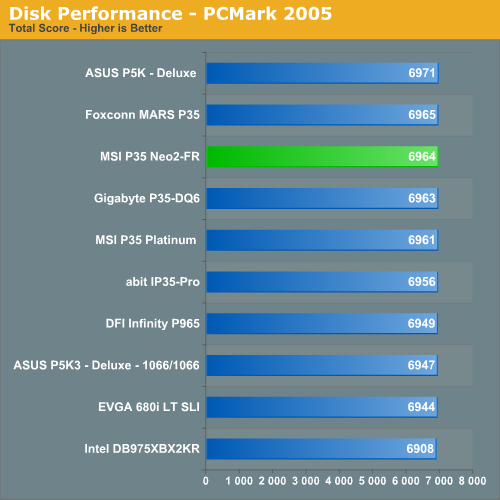
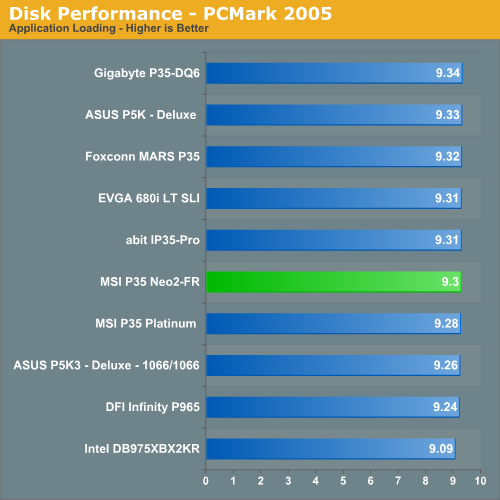
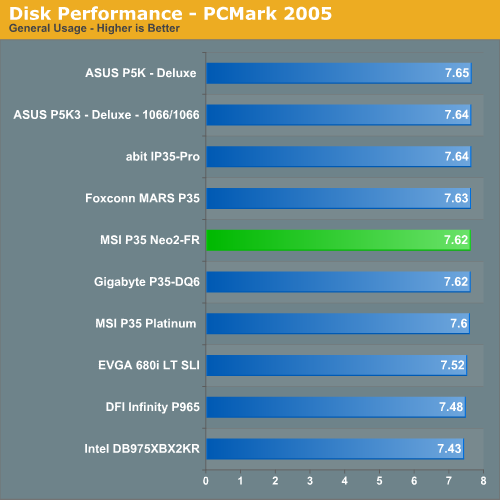
The performance pattern in these tests indicates what we witnessed in actual application testing. In tests that are heavily dependent on the storage system, the Neo2-FR board performs well and generates consistent results in each test. However, the board finishes near the top as it excels in the Write and Window's XP startup tests when compared to the boards.
Ethernet Performance
LAN performance is also an area worth looking at, as these boards might be serving up media to the rest of the house. All of these boards utilize PCI or PCI Express based controllers with the only difference being the supplier of the core logic.
The Windows 2000 Driver Development Kit (DDK) includes a useful LAN testing utility called NTttcp. We use the NTttcp tool to test Ethernet throughput and the CPU utilization of the various Ethernet Controllers. We set up one machine as the server - in this test, an Intel system with an Intel CSA Gigabit LAN connection. Intel CSA has a reputation for providing fast throughput and is a logical choice for our Gigabit LAN server.
On the server side, we use the following Command Line as suggested by the VIA whitepaper on LAN testing:
Ntttcpr -m
4,0,‹server IP› -a 4 -l 256000 -n 30000On the client side (the motherboard under test), we use the following Command Line:
Ntttcps -m
4,0,‹client IP› -a 4 -l 256000 -n 30000At the conclusion of the test, we capture the throughput and CPU utilization figures from the client screen.
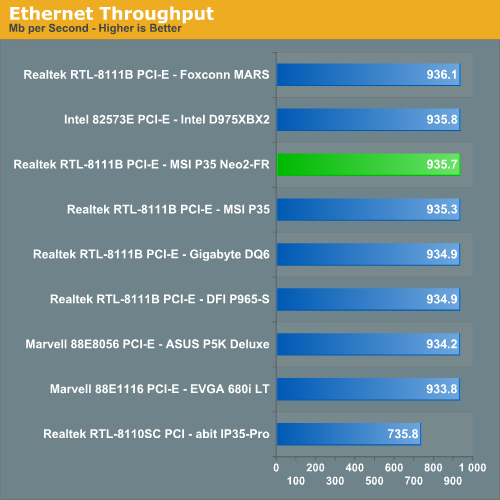
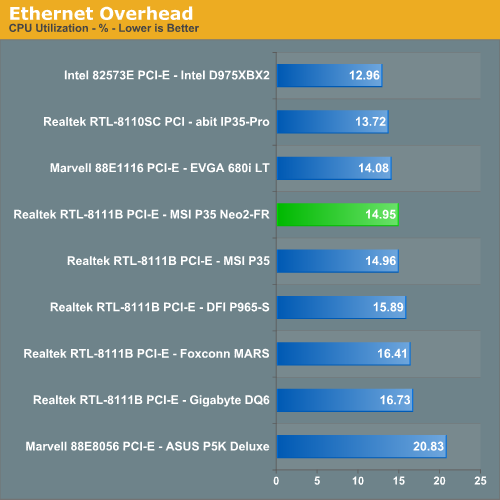
The throughput performance and CPU utilization numbers of the onboard Realtek RTL-8111B are in alignment with the other boards utilizing this chipset. However, any performance differences are slight and not noticeable under normal operating circumstances.










35 Comments
View All Comments
DigitalFreak - Thursday, December 6, 2007 - link
I sincerely hope that the USB port block on the back is supported by more than just that tiny riser. That thing looks like it would break off if you looked at it funny.Griswold - Thursday, December 6, 2007 - link
Nothing to worry about, unless some clumsy fool or 8 year old child rams the USB plug in.superkdogg - Thursday, December 6, 2007 - link
Reading the introduction about the surprising performance of the new MSI board got my ears up, but then I read the article and it was more of the same.Every motherboard performs virtually the same these days at stock speeds. The only things that differentiate anything is overclocking/bios, reliability, layout, price, extra features (if you need them), and personal brand preference.
Motherboard 'reviews' could pretty much be replaced by a table that tells a consumer about those things above. Benchmarking showing that everything is +/- 2% from the median just eats up space.
j@cko - Thursday, December 6, 2007 - link
LOL. I totally agree with ya. Motherboard review nowadays is more about reliability and overclockability, I think.JarredWalton - Thursday, December 6, 2007 - link
The problem is, if we were to eliminate all of the benchmarking, how do we really know if a board is reliable? If you haven't noticed, 90% or something of the text on the benchmark pages is filler - the graphs pretty much say everything you need to know. Anyway, doing motherboard reviews can be a thankless endeavor, but we still think it's necessary. We're not quite at the "necessary evil" stage either. :)brian_riendeau - Thursday, December 6, 2007 - link
Its quite easy really to show the effectiveness of a mobo design without wasting 5 pages on graphs that show no difference between 10 models of motherboards.Test the motherboards in harsh environments. No one really cares if their board is 1% faster than another board, however they will care if their whole system crashes repeatedly if their AC goes out and the room temp gets up to 90F.
drebo - Thursday, December 6, 2007 - link
Death of the P35 Neo-F, one of the best mid-range boards ever made. For $85 you get a superb P35 board, but they're not making it anymore. Moving to this board, you lose Parallel and Serial ports, which for many general home users are very important.Intel doesn't make a P35 board with parallel or serial, and ASUS's P5K board is about $40 more expensive. I really wish a tier 1 manufacturer would come out with another good board. The last couple generations it's been MSI, with the P965 Neo3-F and then the P35 Neo-F. Looks as though there won't be a P35 Neo2-F, unfortunately. They're making a hybrid DDR2/DDR3 board instead, which neuters any kind of RAM upgrades for the end users because you can only use one or the other, not both, and neither in a dual-channel configuration.
Oh well. Maybe ASUS will drop the price of their P5K board.
Ratinator - Thursday, December 6, 2007 - link
[quote]Moving to this board, you lose Parallel and Serial ports, which for many general home users are very important. [/quote]Did you mean not very important?
drebo - Thursday, December 6, 2007 - link
No, I didn't. You'd be surprised how many people at home have serial mice they don't want to replace (old trackballs that they're too stubborn to get rid of) and parallel printers. A lot of people in the business world need them, too. They need parallel for printers and serial to run machines off of, or for their PDAs, or for other reasons.There needs to be a good midrange board that still supports these legacy devices, and with the P35 Neo-F going by the wayside, that board just doesn't exist anymore.
brian_riendeau - Thursday, December 6, 2007 - link
I am sorry to inform you of this, however not many people shopping for new motherboards for business or personal use care about serial and parallel ports. You just gotta let things go man... Anyone who really needs to use a legacy port can pickup USB port -> legacy port adapters for cheap if they really need to use old hardware. We have a whole department of people where I work still chained to serial devices, however they all have C2D and Quad core PCs now and just use USB adapters.